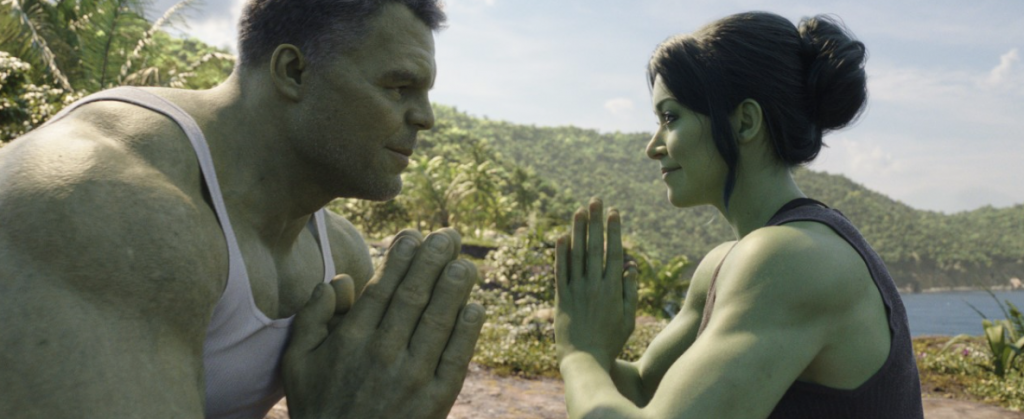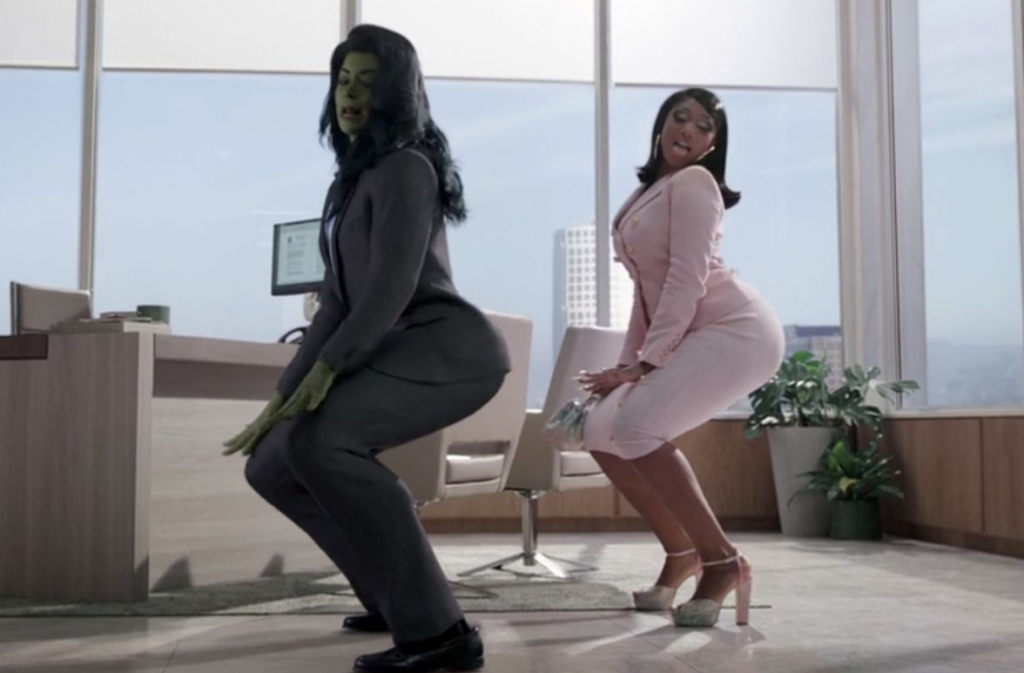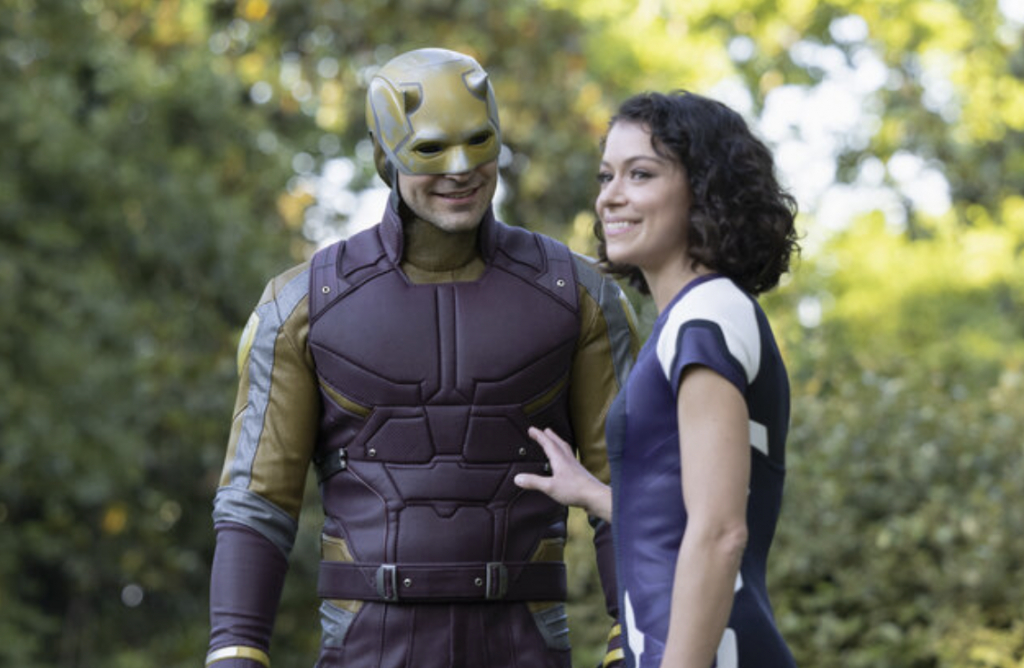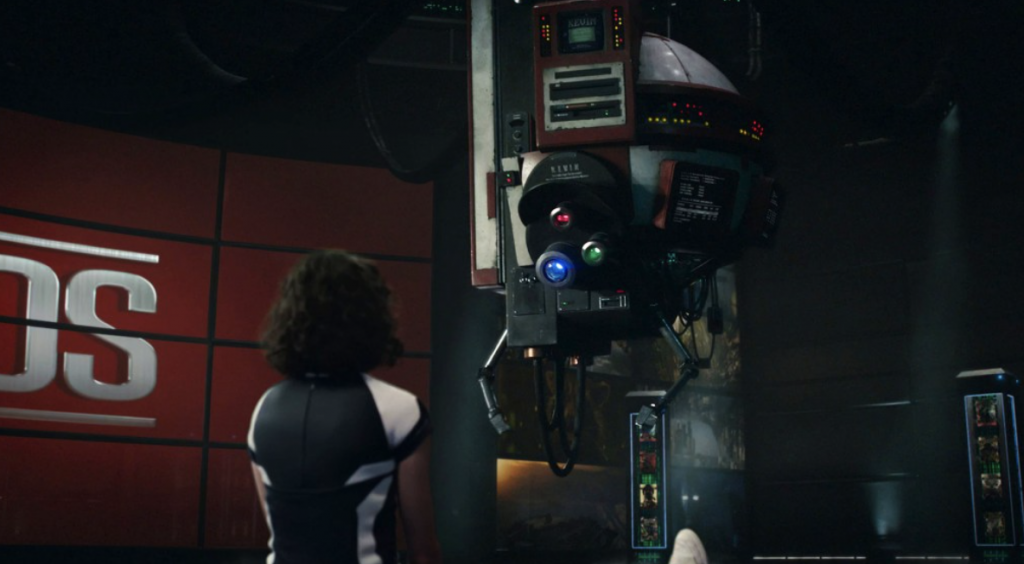Marvel Studios’ She-Hulk: Attorney at Law Review

Owen Mitchell ‘25 / Emertainment Monthly Staff Writer
Yes, Marvel’s She-Hulk: Attorney at Law made a shocking choice in its finale. But did the show succeed in breaking free of the banalities of recent superhero releases, or is it just another forgettable addition to the genre? Spoilers ahead.
She-Hulk: Attorney at Law is a nine-episode series released on Disney+. It tells the story of Jennifer Walters / She-Hulk (Tatiana Maslany), the newest addition to the ever-expanding roster of live-action Marvel heroes.
She-Hulk first appeared in 1980’s The Savage She-Hulk #1 comic, and is known for her iconic fourth-wall breaks, sexual promiscuity, and dual career as a super-human lawyer and Avenger. While many fans anticipated her live-action debut, some were less than thrilled. When the first trailer for the show dropped in May 2022, the show received instant backlash for the sloppy CGI and light-hearted tone.
But by the time the first episode aired in August, things looked promising for the series. Maslany is a delight and shines as the titular role, and Hamilton star Renée Elise Goldsberry is a scene-stealer as Jen’s coworker and rival, Mallory Book. After an accident exposing her to the Hulk blood of her superpowered cousin Bruce Banner (Mark Ruffalo), Jen’s life is turned upside down when she gains the ability to turn into a 7-foot-tall Hulk, complete with a fabulous hairstyle and huge green muscles.
She-Hulk starts off with a clear effort to diverge from the traditional, overused Marvel formula. Episode one, “A Normal Amount of Rage,” delivers a fun twist on the basic superhero origin, as Walters, unlike her male counterpart, is already able to easily control her anger and Hulk form. She doesn’t need help from her superpowered cousin, and heads back to focus on what matters to her — continuing her career.

Unfortunately, She-Hulk runs into the same issues as many of the other Marvel TV shows; it starts off strong, but quickly loses steam. Each episode has a “case of the week” legal comedy format, which works perfectly — that is, until the format is abandoned for no clear reason after the fourth episode, in favor of unnecessary filler episodes that are painfully slow-paced and barely move the plot forward.
So much more could have been explored with the courtroom format, as the cases were a highlight of the show. Both the legal drama and superhero action played second fiddle to character cameos, poor writing, and awkward pacing. Returning guest appearances from Banner, the villainous Emil Blonsky (Tim Roth), fan-favorite sorcerer Wong (Benedict Wong), and most hilariously, rapper Megan Thee Stallion, are enjoyable, but take away focus from the star, catering to the Marvel cliche of stuffing projects full of character cameos. It’s ironic that She-Hulk, a show about female empowerment, relies on cameos from male characters for each episode to keep viewers engaged.

It’s disappointing that the studio seemingly does not trust the character and the lead actress, as Maslany could have had so much more time to shine if given the chance. Yet, Maslany’s She-Hulk does have many great moments – a short fight with her arch-nemesis from the comics turned super-influencer Titania (Jameela Jamil), some hilarious fourth wall breaks, and great comedic moments as she struggles through online dating.
The show rallies in Episode Eight with the triumphant return of Daredevil (Charlie Cox), a fan-favorite brought over from the Netflix show of the same name. After episodes of being teased, the She-Hulk and Daredevil team up is satisfying for fans, but leaves viewers wondering: what next? Going into the finale, it was unclear where exactly things were going. Titania was sidelined early on, and the only villain was a mysterious group calling themselves Intelligencia, in the comics a team of formidable Hulk foes, now a group of incel men who bonded on an internet server over their hatred of She-Hulk and their shared belief that she does not deserve her powers.
It’s an odd choice to make the final villain of the show a bunch of misogynists, but also meta for a show plagued by anti-female hatred from Marvel fanboys. Overall, it’s an underwhelming final conflict, and disappointing that the writers seem more intent on trolling the haters than satisfying the fans.

The finale is a hot mess. She-Hulk has been shunned by the public, fired from her job, and finds the leader of Intelligencia, who has stolen her blood and uses it to turn into a Hulk. Banner, Blonsky, and Titania show up out of nowhere – it’s the beginning of another superhero slugfest, making for the most cliche superhero finale in the book.
“What is even happening here? This is a mess. None of these storylines make any sense,” She-Hulk laments to the audience. “Is this working for you?” Suddenly, the screen flips back to the Disney+ Marvel homepage. What appears at first to be a glitch in the laptop turns out to be one of the most unexpected fourth-wall-breaks ever seen, as She-Hulk punches her way out of her own show and enters the real-life Disney production lot to change her story.
Many Marvel movies are known for playing it safe and trying to appease as many people as possible, so this scene is undeniably one of the boldest choices in Marvel history. She-Hulk goes to confront the top dog, `”K.E.V.I.N.”, a hilarious AI robot spoof of Marvel Studios President Kevin Feige, in charge of pumping out as much profitable superhero content as possible.
While it is fun to see She-Hulk leave the Marvel world and connect with the audience, it’s hard not to wonder if the finale is just an easy out for a group of writers who have no creative way to end the series. She-Hulk’s speech with K.E.V.I.N. is a great way to conclude her character arc throughout the season, as she finally takes control of her own story and identity as a superhero and lawyer. It’s a perfect scene for a character who is known for stepping out of her comic panels to talk to the reader, but as a part of the finale, is unsatisfying and confusing.

At its core, the series has one main issue: it employs all of the tropes it’s trying so hard to make fun of. It’s great to see She-Hulk change her finale to take away all of the cameos and let the spotlight be on her, but did the writers expect audiences to forget that the previous eight episodes relied exclusively on these cameos to tell this story? The choice to create a story that is so flimsy that the main character has to literally break through the TV screen to go change it makes the previous eight episodes feel like a waste of time.
So, while being a fun watch for casual fans, She-Hulk ultimately fails miserably at what it was trying to do. In an attempt to show a character’s struggle to overcome the formulaic and controlling grip of Marvel Studios, the series falls victim to the exact issues it’s trying to escape. While it is satisfying to see Walters fix her story in the finale, She-Hulk loses to the biggest Marvel villain of all: a money-hungry corporation.